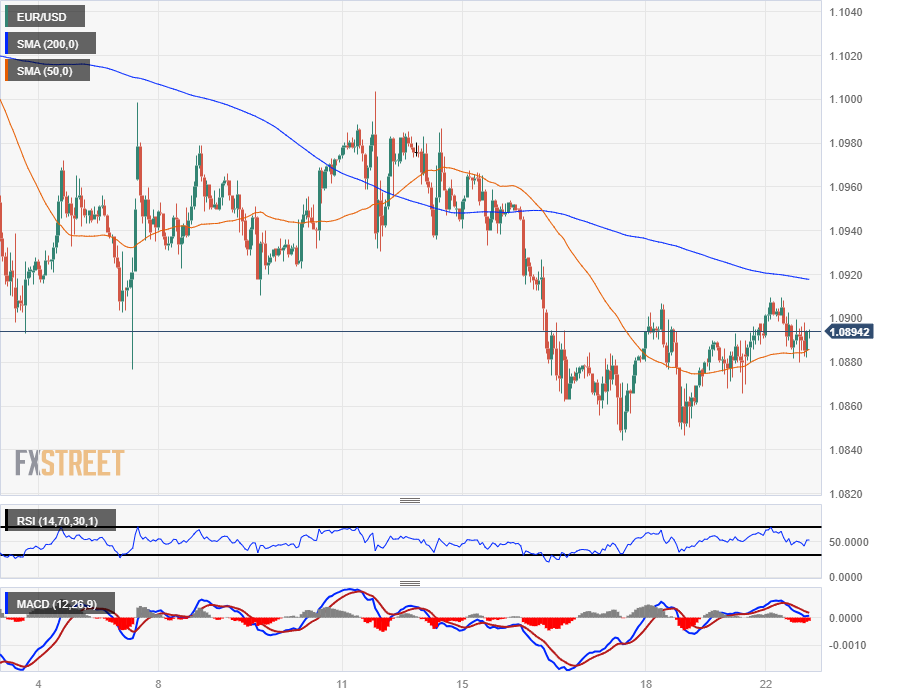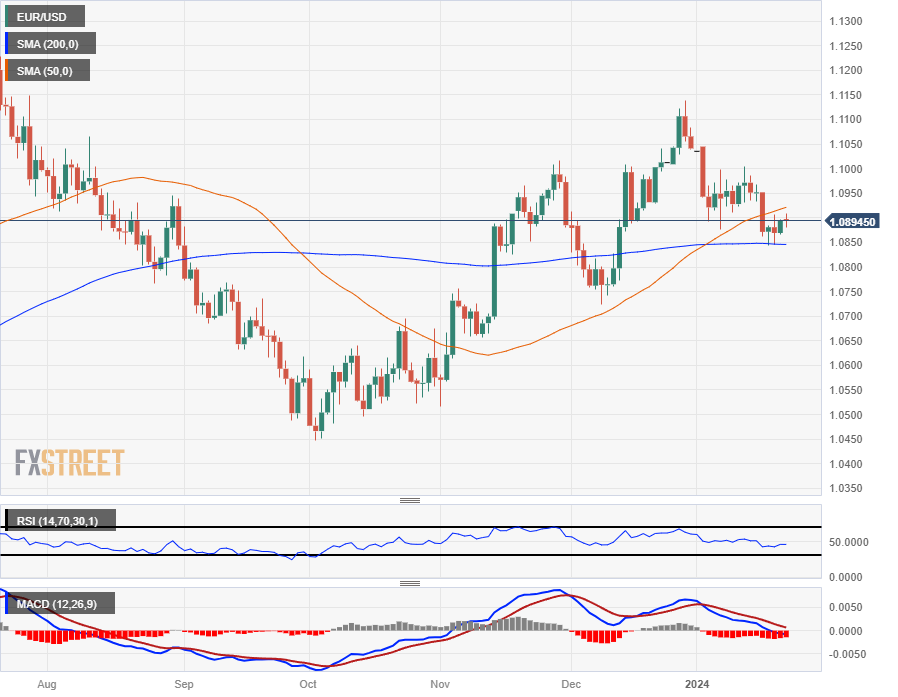EUR/USD tightens into the midrange as markets gear up for this week’s European PMIs, ECB rate call
- EUR/USD continues to get vexed by 1.0900 level in the near-term.
- Europe inflation, ECB rate call in the pipe for the mid-week.
- ECB Bank Lending Survey, euro area January Consumer Confidence due Tuesday.
The EUR/USD is shuffling its feet on Monday as traders take the opportunity to gather themselves up ahead of this week’s hectic showing from multiple central banks across the globe.
Europe sees an update from the European Central Bank’s (ECB) Bank Lending Survey and January’s preliminary Consumer Confidence, both due on Tuesday. Wednesday drops a fresh round of euro area Purchasing Manager Index (PMI) figures, and investors will be bracing for another rate call from the ECB on Thursday.
Daily digest market movers: EUR/USD continues to hold near 1.0900 after trimming gains last week
- A quiet Monday is set to give way to a hectic midweek with an ECB rate call taking center stage.
- Market expectations of rate cuts in 2024 have run well ahead of what policymakers might be able or willing to deliver.
- ECB is firmly entrenched in holding rates steady until summer at the earliest, barring any significant developments in economic data.
- Tuesday’s euro area Consumer Confidence in January is forecast to uptick from -15.0 to -14.3.
- Wednesday’s pan-EU HCOB Composite PMI is expected to rebound slightly in January, from 47.6 to 48.0.
- Germany’s HCOB Composite PMI is likewise seen rising from 47.4 to 47.8 in January.
- With the ECB functionally guaranteed to hold its main reference rate at 4.5% on Thursday, investors will be deep-diving on the ECB’s ensuing Monetary Policy Statement.
Euro price today
The table below shows the percentage change of Euro (EUR) against listed major currencies today. Euro was the strongest against the New Zealand Dollar.
| USD | EUR | GBP | CAD | AUD | JPY | NZD | CHF | |
| USD | -0.04% | -0.23% | 0.14% | 0.15% | -0.13% | 0.27% | -0.05% | |
| EUR | 0.06% | -0.18% | 0.20% | 0.20% | -0.07% | 0.32% | 0.01% | |
| GBP | 0.24% | 0.19% | 0.38% | 0.39% | 0.12% | 0.51% | 0.20% | |
| CAD | -0.14% | -0.17% | -0.38% | 0.02% | -0.26% | 0.15% | -0.18% | |
| AUD | -0.15% | -0.19% | -0.39% | 0.00% | -0.27% | 0.13% | -0.18% | |
| JPY | 0.12% | 0.06% | -0.08% | 0.26% | 0.28% | 0.42% | 0.09% | |
| NZD | -0.27% | -0.33% | -0.52% | -0.13% | -0.13% | -0.41% | -0.32% | |
| CHF | 0.03% | -0.01% | -0.20% | 0.18% | 0.18% | -0.10% | 0.30% |
The heat map shows percentage changes of major currencies against each other. The base currency is picked from the left column, while the quote currency is picked from the top row. For example, if you pick the Euro from the left column and move along the horizontal line to the Japanese Yen, the percentage change displayed in the box will represent EUR (base)/JPY (quote).
Technical Outlook: EUR/USD remains caught in consolidation as markets await the mid-week
The EUR/USD continues to trade into a technical midrange between major moving averages as markets reach a shaky equilibrium between rate expectations and economic outlook between the Euro (EUR) and the US Dollar (USD).
Intraday action continues to squeeze into chart space near 1.0900, capped off by the 200-hour Simple Moving Average (SMA) near 1.0920, and the Euro is down 1.3% against the US Dollar in 2024. Despite recent decline, the EUR/USD is stubbornly holding onto recent technical levels.
Daily candlesticks see the EUR/USD drifting within chart paper between the 50-day and 200-day SMAs at 1.0921 and 1.0845 respectively. The pair’s long-term momentum is still leaning bullish as higher lows continue to march upwards, but topside gains are beginning to thin out and the 1.1000 handle is beginning to form into a hard technical resistance barrier.
EUR/USD Hourly Chart
EUR/USD Daily Chart
Euro FAQs
What is the Euro?
The Euro is the currency for the 20 European Union countries that belong to the Eurozone. It is the second most heavily traded currency in the world behind the US Dollar. In 2022, it accounted for 31% of all foreign exchange transactions, with an average daily turnover of over $2.2 trillion a day.
EUR/USD is the most heavily traded currency pair in the world, accounting for an estimated 30% off all transactions, followed by EUR/JPY (4%), EUR/GBP (3%) and EUR/AUD (2%).
What is the ECB and how does it impact the Euro?
The European Central Bank (ECB) in Frankfurt, Germany, is the reserve bank for the Eurozone. The ECB sets interest rates and manages monetary policy.
The ECB’s primary mandate is to maintain price stability, which means either controlling inflation or stimulating growth. Its primary tool is the raising or lowering of interest rates. Relatively high interest rates – or the expectation of higher rates – will usually benefit the Euro and vice versa.
The ECB Governing Council makes monetary policy decisions at meetings held eight times a year. Decisions are made by heads of the Eurozone national banks and six permanent members, including the President of the ECB, Christine Lagarde.
How does inflation data impact the value of the Euro?
Eurozone inflation data, measured by the Harmonized Index of Consumer Prices (HICP), is an important econometric for the Euro. If inflation rises more than expected, especially if above the ECB’s 2% target, it obliges the ECB to raise interest rates to bring it back under control.
Relatively high interest rates compared to its counterparts will usually benefit the Euro, as it makes the region more attractive as a place for global investors to park their money.
How does economic data influence the value of the Euro?
Data releases gauge the health of the economy and can impact on the Euro. Indicators such as GDP, Manufacturing and Services PMIs, employment, and consumer sentiment surveys can all influence the direction of the single currency.
A strong economy is good for the Euro. Not only does it attract more foreign investment but it may encourage the ECB to put up interest rates, which will directly strengthen the Euro. Otherwise, if economic data is weak, the Euro is likely to fall.
Economic data for the four largest economies in the euro area (Germany, France, Italy and Spain) are especially significant, as they account for 75% of the Eurozone’s economy.
How does the Trade Balance impact the Euro?
Another significant data release for the Euro is the Trade Balance. This indicator measures the difference between what a country earns from its exports and what it spends on imports over a given period.
If a country produces highly sought after exports then its currency will gain in value purely from the extra demand created from foreign buyers seeking to purchase these goods. Therefore, a positive net Trade Balance strengthens a currency and vice versa for a negative balance.
